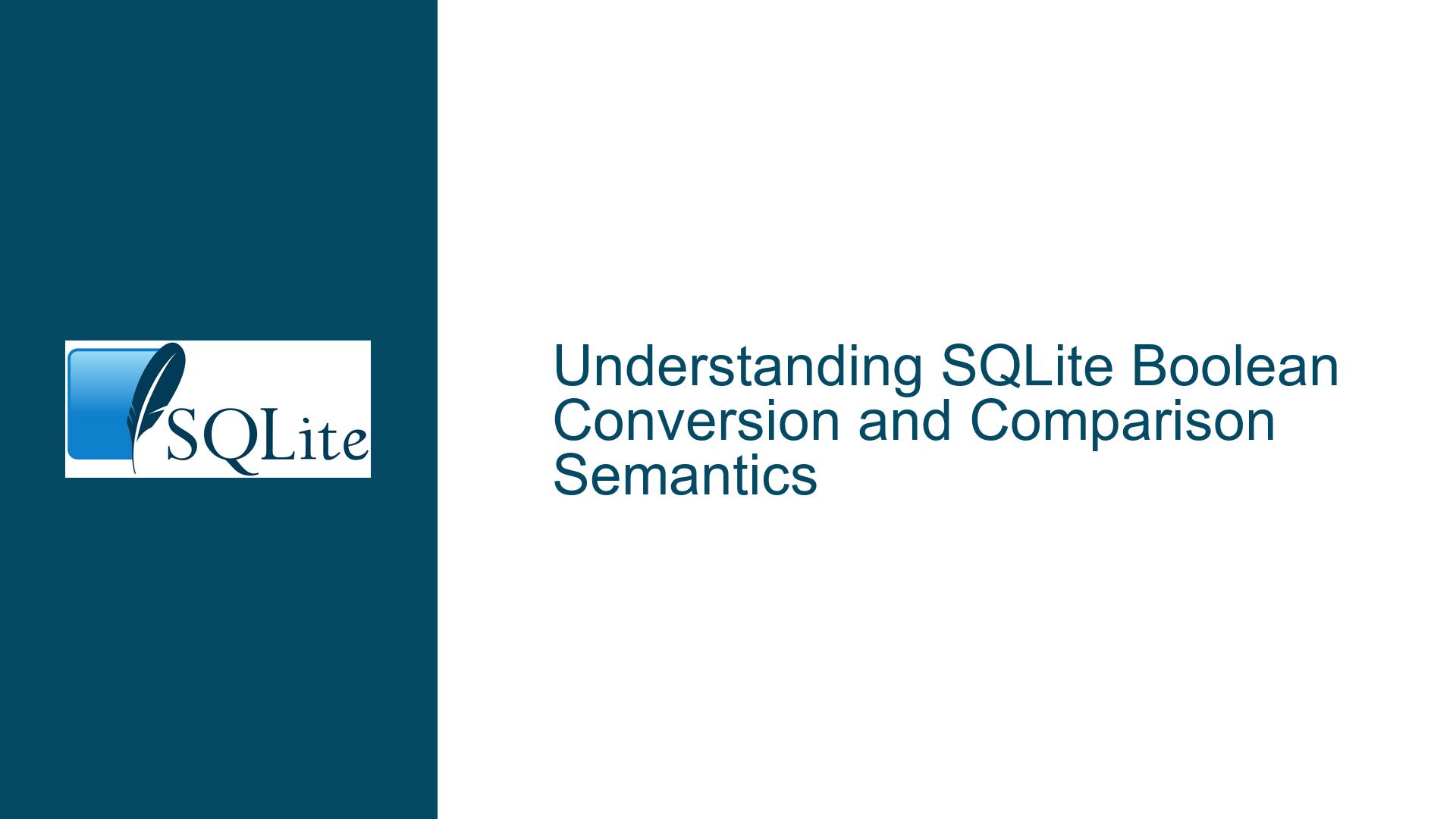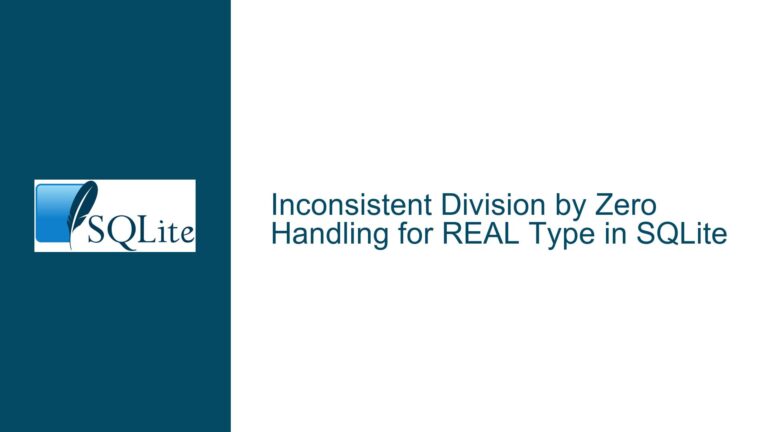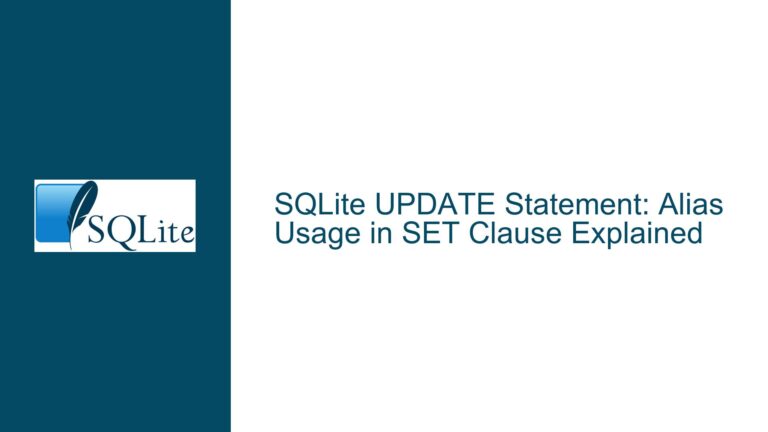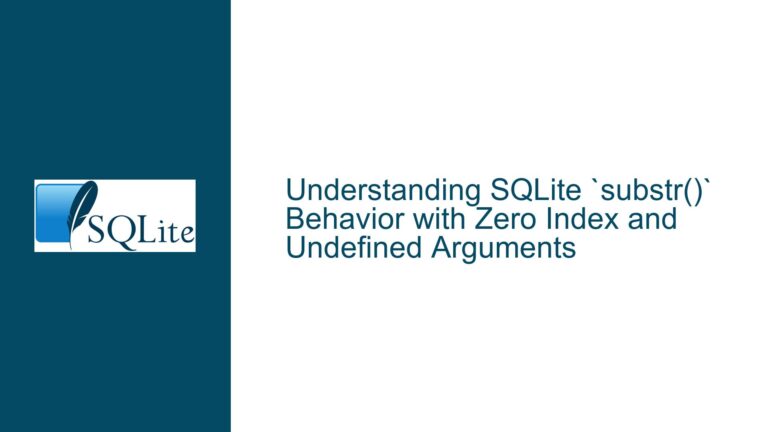SQLite Boolean Conversion and Comparison Semantics
SQLite Boolean Evaluation and String-to-Boolean Conversion Issues
SQLite’s handling of boolean logic and string-to-boolean conversion can be a source of confusion, especially when dealing with implicit type conversion and comparison operators. The core issue revolves around how SQLite evaluates expressions involving strings, NULLs, and boolean logic, particularly when using the OR operator and comparison operators like = and IS. The documentation states that certain string values like '1english' should be considered TRUE, while others like 'xxx1' should be considered FALSE. However, the observed behavior in some cases contradicts this expectation, leading to inconsistencies and confusion.
For example, the query SELECT NULL OR (NULL OR 'xxx1'); returns NULL, even though 'xxx1' might be expected to evaluate to TRUE based on the documentation. Similarly, comparisons like SELECT '1english' = TRUE; return 0 (false), which raises questions about the semantics of the = operator in SQLite. These inconsistencies highlight the need for a deeper understanding of SQLite’s type conversion rules, boolean evaluation, and comparison semantics.
Implicit Type Conversion and Boolean Evaluation Rules
The root cause of these issues lies in SQLite’s implicit type conversion rules and how it evaluates boolean expressions. SQLite does not have a native boolean type; instead, it uses integers to represent boolean values, where 0 is FALSE and any non-zero value is TRUE. When evaluating expressions involving strings, SQLite attempts to convert the string to a numeric value before applying boolean logic. This conversion follows specific rules:
- String-to-Integer Conversion: SQLite converts a string to an integer by extracting the longest possible prefix that can be interpreted as a number. For example,
'123abc'converts to123, while'abc123'converts to0because it does not start with a numeric character. - Boolean Evaluation: After conversion, the numeric value is evaluated as a boolean. A value of
0is consideredFALSE, and any non-zero value is consideredTRUE. - NULL Handling: NULL values propagate through boolean expressions. For example,
NULL OR TRUEevaluates toTRUE, butNULL OR FALSEevaluates toNULL.
In the case of 'xxx1', the string does not start with a numeric character, so it converts to 0 (FALSE). This explains why SELECT NULL OR (NULL OR 'xxx1'); returns NULL: the expression NULL OR 'xxx1' evaluates to NULL OR FALSE, which is NULL, and then NULL OR NULL remains NULL.
However, the confusion arises when comparing strings directly to boolean values using the = operator. SQLite does not implicitly convert strings to booleans in this context. Instead, it performs a direct comparison between the string and the boolean value, which are of different types. Since a string like '1english' is not equal to the integer 1 (which represents TRUE), the comparison '1english' = TRUE returns 0 (false).
Resolving Boolean Conversion and Comparison Ambiguities
To address these issues, it is essential to understand the distinction between the = and IS operators in SQLite and how they handle type conversion and boolean evaluation.
Using IS for Boolean Comparisons
The IS operator is specifically designed for boolean comparisons and NULL checks. Unlike =, which performs a direct value comparison, IS evaluates whether a value is TRUE, FALSE, or NULL based on its boolean interpretation. For example:
SELECT '1english' IS TRUE; -- Returns 1 (TRUE)
SELECT 'xxx1' IS TRUE; -- Returns 0 (FALSE)
In these cases, SQLite first converts the string to a numeric value and then evaluates it as a boolean. This behavior aligns with the documentation and provides consistent results.
Avoiding Direct String-to-Boolean Comparisons
Direct comparisons between strings and boolean values using = should be avoided, as they do not perform implicit type conversion. Instead, explicitly convert the string to a numeric value using the CAST function or use the IS operator for boolean comparisons. For example:
SELECT CAST('1english' AS INTEGER) = TRUE; -- Returns 1 (TRUE)
SELECT '1english' IS TRUE; -- Returns 1 (TRUE)
Understanding the Semantics of = and IS
The = operator in SQLite performs a direct value comparison and does not implicitly convert operands to a common type. This means that comparing a string to a boolean value using = will always return 0 (false) unless the string can be directly interpreted as the same value as the boolean. For example:
SELECT '1' = TRUE; -- Returns 1 (TRUE)
SELECT '0' = FALSE; -- Returns 1 (TRUE)
In contrast, the IS operator evaluates the boolean interpretation of the operand, making it more suitable for boolean comparisons.
Practical Recommendations
- Use
ISfor Boolean Comparisons: When comparing values toTRUEorFALSE, use theISoperator to ensure consistent boolean evaluation. - Explicitly Convert Strings to Numeric Values: When necessary, use the
CASTfunction to convert strings to integers before performing boolean comparisons. - Avoid Ambiguous Comparisons: Avoid comparing strings directly to boolean values using
=, as this can lead to unexpected results. - Leverage SQLite’s Type Affinity: Understand how SQLite’s type affinity rules affect comparisons and conversions, especially when dealing with mixed types.
By following these guidelines, you can avoid the pitfalls of SQLite’s boolean conversion and comparison semantics and write more reliable and predictable queries.
Summary of Key Points
| Concept | Explanation | Example |
|---|---|---|
| String-to-Integer Conversion | SQLite converts strings to integers by extracting the longest numeric prefix. | '123abc' → 123, 'abc123' → 0 |
| Boolean Evaluation | Non-zero values are TRUE, 0 is FALSE, and NULL propagates. | NULL OR FALSE → NULL, 1 OR 0 → 1 |
= Operator | Performs direct value comparison without implicit type conversion. | '1english' = TRUE → 0, '1' = TRUE → 1 |
IS Operator | Evaluates the boolean interpretation of the operand. | '1english' IS TRUE → 1, 'xxx1' IS TRUE → 0 |
| Explicit Conversion | Use CAST to convert strings to integers for boolean comparisons. | CAST('1english' AS INTEGER) = TRUE → 1 |
Understanding these concepts and applying them consistently will help you navigate SQLite’s boolean logic and type conversion rules effectively.






